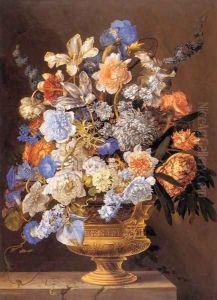Jacques II Bailly Paintings
Jacques II Bailly was a French artist known primarily for his work as a miniaturist and portrait painter during the 18th century. Born in 1725 in Paris, France, Bailly was part of a family of artists, which allowed him to be exposed to the art world from a young age. His father, Jacques Bailly I, was also an artist, though not as widely recognized as his son would become.
Jacques II Bailly's contributions to art were particularly significant in the realm of miniature painting, a genre that was highly popular among the nobility and bourgeoisie in the 18th century. Miniatures were often used for personal keepsakes or as gifts, and they were valued for their intimate scale and the skill required to create detailed representations on such a small surface.
Bailly's work was characterized by its fine detail, clarity, and the subtlety of his color palette. He was adept at capturing the likeness and personality of his subjects, which made him a sought-after portraitist among the French elite. His miniatures are typically found in lockets, snuffboxes, and other small, personal items of the period.
During his lifetime, Bailly witnessed significant political and social changes in France, including the lead-up to the French Revolution. The Revolution, which began in 1789, brought about a shift in artistic patronage and style, but Bailly continued to work and maintain his clientele during this turbulent period. However, the turmoil of the era did not spare him, and he faced the same uncertainties and dangers as many of his contemporaries.
Jacques II Bailly died in 1793, amidst the Reign of Terror, a particularly violent phase of the French Revolution. While the exact circumstances of his death are not well-documented, it is known that many artists and members of the aristocracy fell victim to the widespread executions of the time. Despite the tragic end to his life, Bailly's legacy lived on through his art, which remains a testament to his skill and the elegance of the Ancien Régime.
